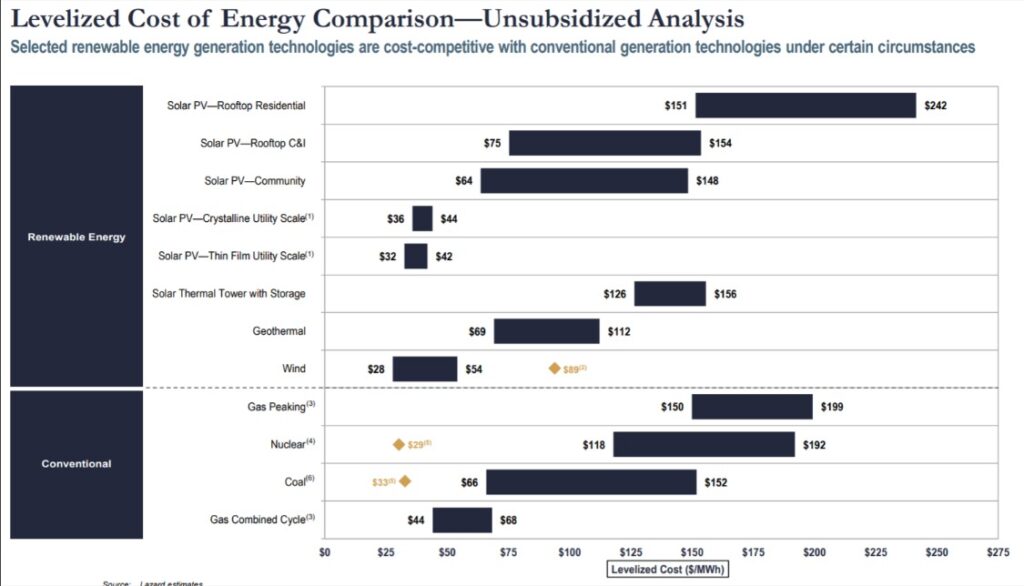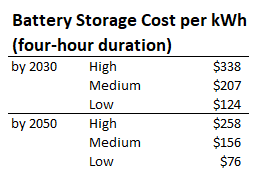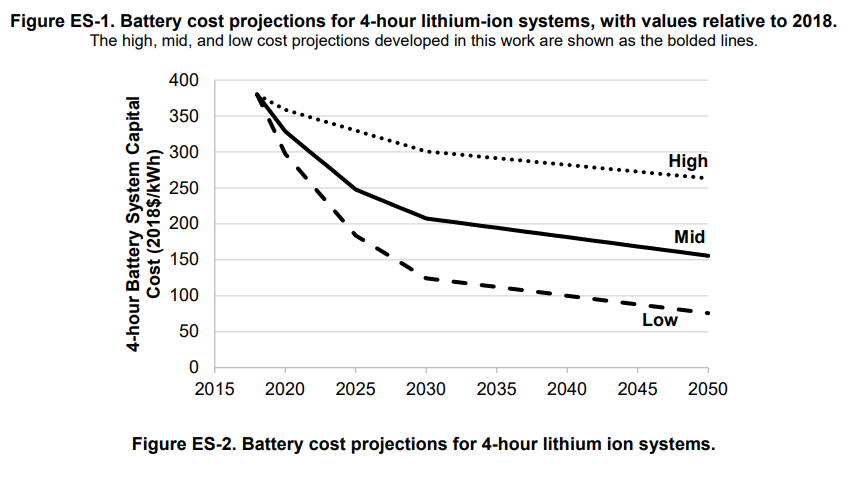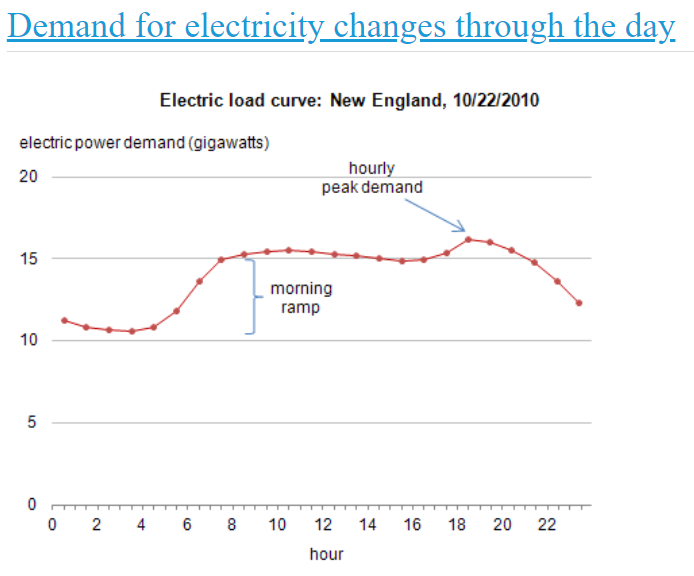by James A. Bacon
The Northam administration has set the goal of achieving a zero-carbon energy grid by 2045, that is, an energy grid that uses zero fossil fuels. Natural gas and coal would be replaced in the Clean Energy Virginia plan Governor Ralph Northam announced yesterday, with “new investments in solar, onshore wind, offshore wind, energy efficiency, and battery storage.”
The key to making a 100% renewable electric grid work is battery storage. Solar and wind power are inherently intermittent, dependent upon weather conditions that cannot be controlled. Renewables advocates say the way to even out the fluctuations in power output is to store excess power in batteries when the sun is shining and the wind blowing, and to release the power when conditions are cloudy and calm. While the cost of battery storage is extremely high now — batteries are used at present mainly to regulate minute fluctuations in voltage and frequency — costs per kilowatt hour (kWh) are expected to decline dramatically, as seen in the chart above.
The questions then become, how much battery storage capacity will we need? How will reliance upon batteries change the need for redundant renewable power facilities? And how much will the package cost?
The Governor’s clean-energy Executive Order of 2019 allowed for nuclear energy in the power-generating mix, but none of his pronouncements since then have mentioned nuclear. The most vocal and influential environmental groups in Virginia oppose an extension of the licenses for Dominion Energy’s four nuclear power units, which are approaching 60 years in operation. Given the environmentalists’ demonstrated power to block energy infrastructure projects, for purposes of discussion in this post, I will examine the scenario in which Virginia’s electric grid gets zero power from fossil fuels and zero from nuclear by 2045.
One advantage of solar and wind is that they have become the lowest-cost sources of electric power. This chart by investment firm Lazard shows the advantage of solar and wind when the Levelized Cost of Energy (LCOE), which includes up-front capital costs, operating costs, and fuel costs over the price of a project, is taken into account.

Click on the image to enlarge it. You’ll see that combined-cycle natural gas is the only fossil fuel that comes close to wind and solar. These numbers show why it is crucial to include a significant solar component in Virginia’s energy mix. (The LCOE for offshore wind in Virginia will be much higher than the average shown above because the infrastructure to install offshore wind turbines is so immature).
However, the Lazard analysis looks at individual energy projects, not the entire electric-generating system. When we look at an entire system comprised of renewable energy built around solar, wind, and battery storage, the picture looks very different. Even a balanced renewables/nuclear/natural gas generating portfolio requires some redundancy for the purpose of maintaining a reliable supply of electric power. A renewables/battery storage porfolio would require far more.
As even zealous advocates of renewable energy acknowledge, the big drawback to solar and wind is that they produce electricity intermittently. Grid operators don’t control when they produce power — weather patterns do. Therefore, a zero-carbon grid needs a way to supply electricity when clouds block the sun and the winds die down. The proffered solution is to create massive arrays of lithium-ion batteries. This cost is not taken into account in LCOE analysis.
At present the cost of batteries is too high to consider them as a source of large-scale energy storage. However, technological advances are driving down the cost. According to a National Renewable Energy Laboratory report, “Cost Projections for Utility-Scale Battery Storage,” the cost of lithium-ion battery systems could decline by anywhere between 25% and 80% by 2050, with a mid-range forecast of 60%.
It’s a good thing that costs are coming down because Virginia will need a lot of battery storage. Let’s start with the challenge of providing electricity over the cycle of daily usage.
Governor Northam has mandated 5,200 megawatts of electricity capacity from offshore wind energy by 2034. Assuming that number is achievable, wind would account for roughly 25% of electric output in a carbon-free grid by 2050, while solar would produce the other 75%. (These are rough numbers. They assume that gains in energy efficiency will roughly balance out the impact of economic growth, and that electricity consumption will be roughly the same in 2050 as it is today. The numbers also ignore hydro and biomass, which are expected to make minor contributions.)
The obvious problem with a 75% solar grid is that solar panels do not generate electricity when the sun goes down but people are still consuming electricity. Electric power consumption at night runs about 60% of the daytime peak in this U.S. Energy Information Administration graph of New England’s electric load curve. (I’ve seen comparable graphs for Dominion’s service territory but could not find one on the Web this morning as I was writing this post.)
On average, a zero-carbon electric grid would have to store enough electricity in batteries during the day to supply roughly 12 hours of night-time electricity demand. In the current system, natural gas and nuclear supply the base-load power. The problem is that we can’t plan an electric grid based on averages. The grid has to accommodate peaks. In Virginia, consumption peaks during the summer. The days are longer — in Virginia, there are roughly 14 1/2 daylight hours in July — which means the solar panels get to work overtime. Goody! However, in the winter, the days are shorter. In January, there are as few as 9 1/2 daylight hours. Although electric consumption tends to be lower on average in the winter than the summer, there are extreme weather events — solar vortexes — in which winter demand spikes. In other words, the system must be capable of storing enough electricity for 15 hours, not just 12, under predictable “normal” conditions — and even more for uncommon events.
The generating capacity of Virginia electric utilities in 2018 was 24,000 megawatts, according to the U.S Energy Information Administration (EIA). That includes output by Dominion, Appalachian Power, the electric co-ops, and various minor entities. Making the simplifying assumption that half of daily electricity consumption in January occurs between 6 p.m. sunset and 8:30 a.m. sunrise when there is zero solar power output, and also assuming that 80% of the state’s electricity comes from solar, we can calculate that Virginia will need battery storage capacity equivalent to 9,600 megawatts to offset the night-time solar shutdown under normal conditions.
Here is the range of NREL cost estimates for battery storage per kilowatt hour (kWh):

Note on definitions: One megawatt of electric output over one hour equals one “megawatt/hour.” One megawatt/hour is equivalent to 1,000 kilowatt/hours.
The medium-scenario cost in 2050 for storing and releasing 9,600 megawatts of electricity over a 14-hour period will be about $4.2 billion. That’s a lot of money, but compared to the cost of re-licensing a nuclear plant, it might make sense.
Here’s the tricky part. This exercise assumes that the solar panels are generating at maximum “nameplate” capacity. In fact, they never do. When it’s cloudy, solar output drops to 10% to 15% of normal — a potentially devastating loss of output. And cloudy days are fairly common in Virginia. According to this graph, more than one day in three is cloudy.

Source: CurrentResults.com
What happens if Virginia experiences a stretch of four or five days of cloudy weather, and solar output drops to 10% to 15% of normal during the entire stretch? You’ll need enough battery storage capacity to supply seven to eight times the electricity they normally do for a single day, maybe ten times that — 70 or 80 times normal capacity — to handle a stretch of five cloudy days. All of a sudden, we’re talking about an investment of tens or hundreds of billions of dollars in battery storage capacity.
That is totally impractical, especially if other states are pursuing the same 100% renewable strategy. Demand for lithium will skyrocket, prices will soar, and the cost of lithium batteries will become prohibitive. As an alternative to create redundancy in batteries, a 100% zero-carbon grid could add redundancy in solar capacity. Build more solar panels to supply electricity to fewer batteries. If solar output diminishes to one-seventh normal, just built seven times as many solar panels! Cost-wise, we’d have a similar result: We’d have to support tens or hundreds of billions of dollars in redundant capacity, this time in solar panels rather than storage batteries.
I have explored only one layer of the challenge here. We also need to consider the impact of extreme weather events — from hurricanes to calms — on offshore wind turbines. We need to take into account the impact of extreme cold on battery efficiency. And we need to examine how much electricity we could import from outside the state, and how much we would need to expand our electric transmission system to meet a shortfall. It gets very complicated.
Here’s the bottom line: Virginia can’t build a renewable electric grid to work “most of the time.” It must be resilient enough to supply electricity during periods of peak demand and in conditions of not-uncommon weather. No matter how “smart” we make our grid, now matter how many micro-grids and rooftop solar installations we create, a 100% carbon-free grid would require massive redundancy — tens of billions of dollars’ worth — in order to create that resiliency. The architects of the 100% carbon-free grid have not come close to grappling with this issue.




